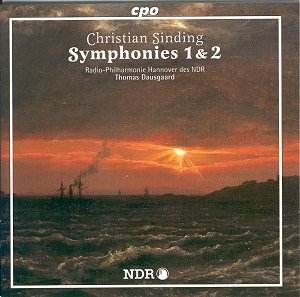Having devoted a good deal of time and energy to promoting
the causes of a range of underestimated composers (first among them
Stanford) I know how infinitely galling it can be when finally a major
work gets a hearing and the critics, on a single hearing and without
any background knowledge, lash in. "How can they be so stupid as
not to hear this, that or the other?" I find myself muttering,
torn between anger and anguish. So, before pitching in myself, I try
to remember that there may be people out there who have been waiting
for years to hear these works (well, actually this is their second outing
in recent months, they are also available from Rasilainen and the Norwegian
Radio Orchestra on Finlandia 3984-27889-2), hoping and praying that
the gospel of the composerís greatness will finally make its way around
the world. For all I know there may be Sinding Societies and Sinding
Pressure Groups dotted all around Norway, and if there are I think Thomas
Dausgaard must belong to them all, for he conducts not just with conviction
but with a rightness of pacing that makes you think heís had them in
his repertoire all his life. I donít want to upset anyone. But dammit,
somebody, somewhere must have written some boring, uninspired music,
and why shouldnít it be Sinding?
The opening movement of the first Symphony is actually
rather promising, with striking themes and a definitely Nordic-heroic
tone. It depends overmuch on insistent rhythms to keep going but it
sustains its length fairly well. So, too, does the second movement.
Climaxes can be a bit brassy but there is an imaginative moment where
horn and solo violins weave around one another. Unfortunately the work
seems to run out of steam at this point. I found little to engage me
in the scherzo (though the trio was jolly) and my only memory of the
finale at the time of writing (about an hour after hearing it) is that
it went on for a long time without gathering any momentum. Itís rather
sad that Sinding laboured so long (he began it in 1887, the second version
was performed in 1890 and a third, final, version had its première
in 1894) to produce so little. Itís just a thought, but I suppose the
final version is the best?
The second Symphony was premièred in Berlin
by Weingartner in 1907 Ė Sinding was very highly regarded in his day.
Itís "better" in the sense that there is more variety to its
pacing, its construction is clear and the post-Wagnerian orchestra is
handled with complete mastery. If well-made music is "good"
music then this is "good" music. But if the object of music
is to inspire, to move, to involve the listener, then is this really
music at all? Is there anything here that "only" Sinding could
have written? A trace of a personal voice can be heard amongst the naiveties
of the first Symphony, but it sounds terribly as though the acquisition
of a sound compositional technique choked it. The notes to the CD are
devastatingly fair in that they quote a contemporary review of the first
performance of the second Symphony which found the piece a thorough
disappointment.
In 1919 Sinding completed a further Symphony, premièred
under Nikisch in Leipzig the following year. Now we have two recordings
of these first two I suppose one or other conductor will want to finish
the cycle. Will the later work confirm the impression of a slender talent
which slid into mediocrity, or was the second Symphony the product of
an off-day?
Perhaps we are looking for the wrong thing. In Sindingís
day contemporary music was not a taboo, limited to a noisy clique, it
was normal for several new romantic symphonies to come out every season,
they were not necessarily expected to last (did Weingartner and Nikisch
ever conduct these works again?). They were the prose background against
which the occasional masterpieces were produced. Lucky Sinding who lived
at a time when there was money to be earned by writing musical prose.
Nowadays you could programme a computer to write a romantic symphony
and churn out works like this by the billion.
So, no masterpieces here, in spite of fine presentation
by conductor, orchestra, recording team and booklet-note writer. The
cover is unwittingly emblematic. It is a reproduction a painting by
Johann Christian Clausen Dahl, showing a black, foam-flecked sea almost
meeting a threatening black sky with a strip of red sunset between them
and a steamer battling its way across the scene. Itís mightily impressive,
until you stop to think how many black foam-flecked seascapes with red
sunsets you must have seen that look mightily impressive in exactly
the same way. And isnít that rather what the musicís all about?
Christopher Howell


